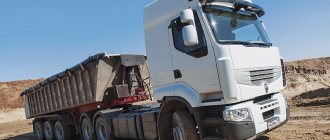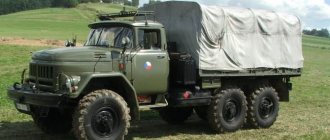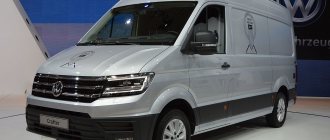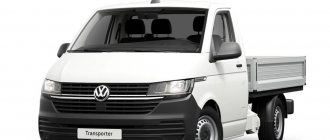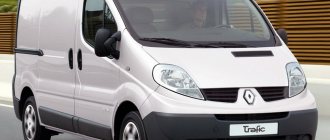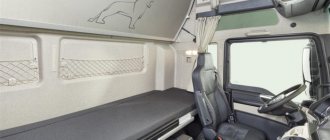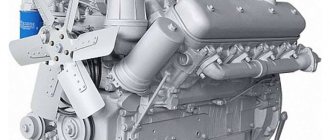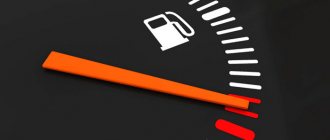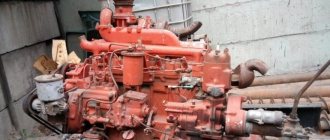Renault Premium is a Renault truck that has a large number of modifications that differ in body type and load capacity. Production of the first generation Renault Premium began in 1996. The ideological predecessor of this truck is the Renault Manager model, as well as its co-platform version Renault Major. Renault Premium's closest competitors include DAF 95, DAF XF, Iveco Eurostar, Scania P-Series, Volvo FM and others.
The carrying capacity of the first generation Renault Premium is in the range of 18-26 tons. The car received 60 modifications, as well as several wheel configurations - from 4x2 to 8x4. In addition to the carrying capacity and wheel arrangement, all modifications have a specific type of purpose.
Since 2006, the second generation Renault Premium has been produced.
Renault Premium owner reviews
- Andrey, Kirovsk. The odometer of my Renault Premium shows 180 thousand kilometers, the car is still in its prime, so to speak. Its carrying capacity can exceed 20 tons, and fuel consumption reaches 30-40 liters, depending on the load. I have a Premium 400, a 2003 car. With automatic transmission and full power accessories. We were pleased with the visibility and brakes.
- Dmitry, Irkutsk. Renault Master is a real hard worker. First generation truck, 1999, with a mileage of 1 million kilometers. Still on the move. We service the car in our own service, which is provided by our freight transport company. All spare parts are available - used ones though. The car with a diesel engine and an automatic transmission is quiet and smooth. Consumption is around 35 liters per 100 km.
- Sergey, Tyumen. Renault Premium drives well on the highway, as well as on rough city roads. The energy-intensive chassis is designed for any road, including rough terrain. A car with a 400-horsepower engine, Renault 400 model. In the city, the car consumes 40 liters.
- Georgy, Nizhny Novgorod region. I have a Renault Premium hitch. Machine with a lifting capacity of 20 tons. Engine 3700DCI with Euro 3, fuel consumption at 35-40 liters depending on the number of accelerations. It's much more economical to drive on the highway, since I drive at the same speed. In this case, you can keep within 30 liters, no more. The car is comfortable and has an energy-intensive suspension, but the cabin is very noisy. A car with an automatic transmission that changes gears quickly.
- Dmitry, Smolensk. I’m a truck driver, I’ve been driving a 385-horsepower Renault Premium for three months now. The other day, the engine began to overheat, which in good condition pulled well in a wide speed range. I have a 2006 version, modification 440DXi. The engine is demanding on fuel quality, but at the same time it uses fuel economically. In the urban cycle, up to 40 liters are obtained, and in the suburban cycle – up to 28-30 liters. I have driven 90 thousand kilometers, the car is very comfortable and quickly reaches 100 km/h. Being 180 cm tall, I can walk around the cabin without bending over - the interior is so spacious. On the highway the car rides smoothly, like a car.
- Vitaly, Yaroslavl. I've been driving a Renault 400 2000 for 18 years now, the car is generally not bad, but sometimes it gives surprises. Frequent problems: excessive consumption of fuel and oil, problems with the cylinder-piston group, electrical and fuse failures, and power windows only work at times. A car with a 400-horsepower diesel engine consumes 40 l/100 km.
- Ivan, Priozersk. I have driven the Premium for more than 600 thousand kilometers, the car is very economical. 20 thousand km ago there was a problem due to which the consumption reached 50-60 liters. I replaced the nozzles, changed the oil and did a flush. As a result, consumption was reduced to 34-28 liters, depending on the load.
- Igor, Ekaterinoslavl. A good car, one of the most affordable and practical heavy duty trucks. A car in the popular 400 modification, version 2001, with a diesel engine and automatic transmission. Fuel consumption is around 30-40 liters, depending on driving style and load capacity.
- Boris, Penza. The car was manufactured in 1998, purchased in 2010 with low mileage. Registration number – Т266НР59, engine – diesel, 9.9 liters, power 380 horsepower. To date, the mileage is 1 million 300 thousand kilometers. This is not a new car, so breakdowns occur regularly. But with timely maintenance, the car is very strong and can withstand road irregularities with dignity. There is enough power to provide powerful traction even on slippery roads. Fuel consumption is 30-40 liters per 100 km.
- Nail, Minsk. This time the transport company provided me with a Renault Premium 2005, a version of the Renault Premium 400. The diesel engine does not pull well, despite its high power. With a 22-ton load, fuel consumption is 50 liters per 100 km. If you load no more than 4 tons, then you get 30 liters. In “empty” mode the machine consumes 28 liters.
- Alexander, Saratov. In our transport sector there are only foreign cars, but they are already elderly. For example, one of them, Renault Premium 400, is always annoying with breakdowns. The engine is especially capricious - fuel consumption reaches 55 liters, and blue smoke comes out of the chimney. The reason is that the injectors are often filled.
- Alexey, Krasnoyarsk. I have a Renault Premium 2002, I have driven 200 thousand kilometers on it. This is not much, the car is almost not worn out. The chassis is very strong. The automatic transmission ensures a smooth and soft ride, and all road irregularities are overcome at a decent speed - there is no need to brake sharply. The car is equipped with a 450-horsepower engine, fuel consumption is 40 liters per 100 km.
Renault Premium dCi
A. Trokhachev, photo by the author
The official birthday of this car is April 24, 1996. From then until the model change in 2005, the first Premium was sold in 110 countries around the world with a total circulation of more than 100 thousand copies. The success for commercial vehicles is undoubted. In Russia, this car became a bestseller thanks to the Vostok and Vostok-2 package versions, and now it dominates the supply of used Renault trucks.
Love Renault like your soul
| The power steering filter with spring must be changed at the same time as the power steering fluid. As a rule, after 2 years or 150 thousand km |
More than 10 years ago, Premium replaced the Major and Manager models. The good old hard workers have dispersed to almost all continents, including Africa. In other countries, having long ago surpassed the mileage limit of 2 million km, they continue to carry cargo, striking with their “indestructibility”. At the same time, many of them are not exploited in a gentle manner: “Love your car like your soul. Shake him like a punching bag."
Already during the world premiere in Barcelona, Premium was presented in two basic versions: Route and Distribution. Both were supplied to our country. During the production of the car, several thousand Premiums were imported, mainly in the version of truck tractors. Only through the Renault Trucks representative office in Russia in 2006, four hundred Premium dCi vehicles were sold.
Experts divide Premium into dCi (first generation) and dXi (new range). The dCi designation is due to a common rail engine with V-MAC electronic control. This system analyzes various operating parameters of the truck and calculates the optimal injection timing. This improves fuel combustion, improves engine performance and reduces fuel consumption. By the way, according to this criterion, Premium is one of the best representatives of heavy-duty commercial vehicles. In addition, V-MAC monitors and regulates the braking process, controls the engine brake and the transmission retarder. The system also includes cruise control, which ensures optimal driving in the selected mode.
The V-MAC complex includes two blocks that record information from the engine, brake system, and gearbox and process it in real time. The obtained data is stored for diagnostics and analysis of information related to operation. Carriers do not remember cases of V-MAC failure due to the fault of the manufacturer.
The Common Rail electronic injection system is also one of the advantages of the car. It ensures that torque is maintained at low speeds, reduces the noise of operating units, and optimizes the technical characteristics of the engine while driving. Moreover, it takes into account the driving style of any driver, gives him confidence behind the wheel and actually reduces fuel consumption.
The first-generation Premium received an Airtronic rear air suspension with air cushions, the volume of which is controlled electronically. To make the driver's work easier, there is a remote control that allows you to raise and lower the saddle level within a range of 240 mm. All this makes coupling and uncoupling of a tractor with a semi-trailer as simple as possible. And for machines operating with low removable equipment, front and rear Airtronic Integrale air suspension with electronic adjustment is provided. The front range is 200 mm, the rear – 240 mm. According to reviews from carriers, they did not have any problems with pneumatic elements.
| The front headlight is a timeless design as long as it doesn't catch a rock or get hit in an accident. |
French cars use air-driven front disc brakes and wide rear drum brakes. On truck tractors with a 4x2 wheel arrangement, all brakes are disc brakes, with EBS (Electronic Baking System) and a WCS (Wear Control System) pad wear control system. There is also a braking energy distribution system CECS (Coupling Force Control System) and transmission of brake wear information WMS (Wear Monitoring System). But there are no special complaints about them, with the exception of “flying out” springs. Before the model was discontinued, the designers did not have time to solve this problem, so it is typical for absolutely all modifications.
Premium uses engine braking to effectively reduce speed. At the same time, the braking power is 220 kW at 2100 min-1. The gearbox is equipped with an Intarder hydraulic retarder with a retarding power of 500 kW. According to transport workers, it is quite reliable and resistant to overheating: braking efficiency remains unchanged even with frequent use on mountain roads.
The P1370 drive axle without wheel gears deserves kind words. It has excellent energy characteristics and almost never lets carriers down. It is not surprising that at branded service stations many service specialists found it difficult to answer what its real life was - they had no practice of replacing it under warranty. For work in difficult conditions, axles with wheel reduction gears are provided. However, the practice of using tractors in Russia has shown that for most transport enterprises this is an unnecessary expense.
In Russia, Premium is found mainly in two types of cabins - Single and Privilege, although there are only three of them. Doors with spaced hinges open to an angle of 90°. Together with wide and deep anti-slip steps, they provide easy entry and exit. True, the lower step suffers greatly from moisture, dirt and mechanical stress (hitting curbs, falling into potholes, etc.). The floor in the cabin is at different levels: in the area of the driver's seat it is lower, and in the living compartment, which occupies 2/3 of the cabin, it is slightly raised. The total volume of shelves and drawers in the Single cabin is 350 liters, and in the Privilege - even more. The relaxation area is a salon that combines the functions of a passenger seat and a sleeping shelf measuring 2x0.8 m. A second folding shelf was installed on request. The internal height of the cabin is 2 m, which allows you to move at full height.
The ergonomics of the driver's seat are also excellent: all the most important things are at hand. The tachograph is easy to use thanks to a retractable panel similar to the CD player. Some people manage to break off the moving part, but here you can only blame the one whose hands are “accustomed to axes”... The high seating position of the driver allows him to fully control the situation along the route and navigate changing traffic conditions. Truckers note good rear visibility and the absence of “dead” spots, quick defrosting and fogging of the mirrors when the heating is on. In addition, according to them, the favorable location and shape of the exterior rear-view mirrors protect the side windows from contamination, which is not a small thing in Russian conditions.
| The rear shock absorber lasts quite a long time, at least 100 thousand km, provided that a possible defect in the part has not been discovered during the first thousand kilometers. |
To optimize load capacity, Premium was produced in two types of tractors and trucks with a 4x2 and 6x2 wheel arrangement. Trunk tractors with a saddle height of 1100 mm were intended for towing semi-trailers with side loading and unloading with an internal height of 2.70 m. Saddle tractors with a towing height of 950–970 mm were used to tow Mega Trailer type semi-trailers with an internal height of 3.0 m, with a capacity of 100 m3 and designed to load 34 euro pallets. Trucks with 4x2 and 6x2 trailers with a frame height of 850 mm and a third axle with single wheels were intended to form road trains with a useful volume of 120 m3, designed for 38 Euro pallets or 30 ISO pallets.
"East"
Exclusively for the Russian market, two Premium specifications were consistently created: “Vostok” and “Vostok-2”. They were maximally adapted to operating conditions in our country and reflected the main wishes of carriers regarding the vehicle configuration.
The Vostok-2 series vehicles are equipped with an AFI 2000 instrument panel, which displays fault codes on the on-board computer screen. In the event of a breakdown on the highway, the driver can use the menu of this display to see what errors are displayed by the electronics, and find the explanation in the operating manual. Having received the information, he decides whether to stop and wait for technical assistance or get to the nearest service center on his own.
On Vostok-2, which was adapted specifically for Russia, thermal insulation of the cabin was initially installed (which, by the way, is not present on the European versions of Premium dCi - this option is not in demand there due to the mild climate). The heating system is more reliable because the rubber tubes are made thick, in accordance with the climate norm. The engine cooling system is designed to work with antifreeze at ambient temperatures down to –40 °C.
Vostok-2 was delivered to Russia with only one type of cabin - high, deep. Cars with a high cabin, but without a berth, or with a berth, but in a low cabin, were often imported from abroad. Both are not suitable for Russian carriers. However, many people take what is available. Vostok-2 was equipped with an autonomous heater Webasto AT2000, which allows you to heat the cabin when parked with the engine off. The on-board ventilation and heating system works more efficiently than on European versions. This car is equipped with heated side mirrors, so there is simply no need to lay additional electrical lines or install heated reflective elements. The on-board computer and electrical equipment are designed to operate in more severe conditions, at subzero temperatures. So if you choose between a car from the EU and a Russian specification, it is better to give preference to the latter. Vostok-2 is serviced with a service interval of 30 thousand km.
| The turbine has an almost indefinite snail mechanism. It is necessary to ensure that the blades themselves are rigidly fixed to the blade axis and do not touch the body. The sound is pronounced and the turbine is easily accessible - you can always see if there is mechanical damage from the blades |
For a new car, the first maintenance was at 20 thousand km, then the interval was 30 thousand km. This figure is taken from operating conditions, and in Russia they are very strict. If we take the prices of the Leon-Truck service station in Solnechnogorsk near Moscow, then the cost of minimal maintenance with the replacement of filters, oils and standard work according to the Renault technological map is 13,500 rubles. If the oil is semi-synthetic or synthetic, then with additional work the carrier will have to fork out about 16,000 rubles. And when changing the oil in both the axle and the gearbox, the amount increases to 22,000 rubles.
Package cars for Russia came with folding side fairings and a roof spoiler. These devices not only reduce fuel consumption, but also, due to their mobility, provide easier access to the rear of the cab, even when the tractor is coupled to a semi-trailer.
Our realities
In European transportation, where the distance is usually covered in one day, short cabs are often used, which are unpopular in Russia. Our carriers are ready to take (and are actively taking) English transport citizens with right-hand drive, but not with an “orphan” cabin. A passenger cabin with a rear compartment for four people, with seat belts for each passenger, was also offered as special equipment. If desired, it can be used as a bedroom, but this configuration did not become a hit in our country. The work of a truck driver is too hard to interfere with the driver's rest. And that’s why we fell in love with the Premium with the most comfortable Privilege cabin (of course, with the exception of car transporters with a low ceiling).
The largest list of work is for cars purchased abroad second-hand or from European trucking companies. It is quite difficult to find out in what real conditions the Premium was operated and in what condition its components and assemblies are. The fact is that most of this equipment comes without appropriate documentation. It is only possible to determine the mileage of the car through the engine control unit during diagnostics. Based on the mileage, it is easy to calculate the service life: according to the standards, 1 hour is equal to 50 km. The rest is determined visually, that is, by eye, since in some cases the service book is not included with the car. There are also simple devices that allow you to determine whether the cabin has been repainted (i.e., had mechanical damage). To do this, just place the tester on the surface, and it will immediately display the thickness of the paint layer in microns. If it turns out to be higher than the factory standard (100 microns) or the device does not give any readings, it means that the layer of primer and paint exceeds the original values. But even if the car has not been in an accident, it is usually necessary to carry out an impressive list of work, from changing the oil in all components and assemblies to adjusting valve clearances and replacing individual parts. Such a machine will have to be left in operation for 6–8 hours, i.e., in fact, for the whole day.
| The generator is also one of the long-lived onboard ones. The only thing that can bring it down prematurely is an excessive number of additional electricity consumers creating an unreasonably high load. |
It must be borne in mind that right-hand drive cars have their own specifics. Their advantage is more reliable electrical equipment, and their disadvantage is additional costs for servicing in Russian conditions, including conversion to a left-hand drive version. The fact is that there are no conversion diagrams, and it is very difficult to figure out which harnesses go where and how they need to be re-laid. If in the usual version the car is serviced by one electrician, then here there are two, and this is an additional cost for standard hours of exactly 2 times. The most unpleasant thing is that a lot of electrical problems arise precisely after converting a right-hand drive car into a left-hand drive one.
It is important to remember that Premium is not intended for on-road repairs. Even an oil change is recommended to be done at a service station. Each car has an on-board computer that monitors operating parameters and alerts the driver about maintenance intervals. The display shows information that after so many kilometers you need to stop at a station for scheduled maintenance or an emergency oil and filter change. During a visit to the service center, the work performed is either reset or transferred to the next time. And you can do more damage on your own than you can repair.
Experience shows that carriers are not always aware of what kind of oil to treat their engines with. We are not talking about pouring exclusively the same product with the same degree of viscosity, although this is precisely the most competent approach. If the engine uses semi-synthetic 10W40 and there is no oil of the same brand, topping up with any semi-synthetic 10W40 is allowed. And when using 15W40 mineral oil, you can restore the normal level with a product with the same designation 15W40. It would seem to be a truism, but a certain part of drivers do not adhere to it.
There are “dummies” who add mineral water to semi-synthetics and vice versa, believing that nothing bad will happen. Sometimes you have to explain to such kulibins on your fingers: they say, you can’t drink milk with lemon juice - it will curdle. Likewise, oils with different properties with individual additives cause harm to the engine instead of benefit: the sediment that falls out in this case can seriously affect the life of the power unit. How to explain to another driver that each type washes away the existing oil film and develops its own. The bad thing is that during this “castling” the engine may experience oil starvation, and rubbing parts suffer an increased degree of wear. By the way, the manufacturer does not recommend flushing the engine when changing the oil due to the risk of increased wear of parts of the cylinder-piston group.
| The accelerator pedal differs from the Magnum model in that it is floor-mounted and not suspended, as on the Premium. But experts assure that if necessary, it is also applicable. And in terms of demand – one of the “hottest” parts |
The benefit of repairing at a company service, rather than on your own, is that the contractor provides a guarantee for the work performed. At official Renault Trucks dealers, everything depends on the type of operations. For example, there is no guarantee at all for fuel equipment, since it is impossible to determine how high-quality fuel the client is refueling with. The chassis and engine (if found to be the manufacturer's fault) are covered by a 1-year warranty. In the event of a breakdown of the unit or a malfunction in any system due to the fault of the service, the replacement is free of charge for the carrier.
Let's praise
The summary of most carriers delivering cargo with Renault Premium is this: overall the car is reliable.
The engine is very reliable. As practice has shown, dCi 11 runs more than 1 million km without problems. Of course, provided that maintenance is carried out in a timely manner and in full. Neither in Russia, nor in Belarus, nor in Ukraine are there any cases where the dCi 11 engine was changed under warranty - there was not a single failure due to the fault of the manufacturer. There were no recorded complaints regarding bridges during the period of the factory warranty. If there were any cases, it was only through the fault of the operators. By the way, currently axles under the Renault brand are produced by the American company Meritor.
Gearboxes and ZF gearboxes fail extremely rarely. The high reliability of transmissions of this brand is confirmed by the loads that these products withstand during the most difficult Dakar rally raid. And those episodes that service specialists talk about occurred due to the fault of drivers who unknowingly violated or deliberately ignored the manufacturer’s recommendations. Usually problems arise due to the fact that the driver did not pay attention to the lack of oil or did not notice the oil seal leaking.
The front brake pads last 200 thousand km. There are no problems with them, provided that the driver carefully monitors the condition of the springs and calipers. If you missed the moment when the calipers began to dangle, the linings can quickly break, since they are designed for clamping load, and not for vibration impact. The rear pads last 600 thousand km. With proper care there are no problems with them. But if the ratchets are not tightened or they begin to wedge and bite, the pressure springs fly off.
| The belt tensioner roller, as a rule, is changed along with the belt, once you have dismantled it. And according to experience, it lasts until the engine is overhauled and is not written off separately |
Rubber on the drive axle travels approximately 350 thousand km, on the steer axle - about 300 thousand km. But this is subject to constant monitoring by the driver. If he fails to notice that the tires are “eating up” somewhere, the service life is reduced not by percentages, but by several times.
Let's chide
Carriers do not hide the fact that many of those who bought Premium new, without mileage, switched to servicing on their own after the warranty expired. The reason lies in the fact that the salary of the company’s mechanics is cheaper than paying standard hours at a company service station. It’s one thing when we are talking about planned operations (it’s not a sin to contact a professional service center), and quite another thing when you need to transfer the engine, gearbox, rebuild the rear axle, or assemble one working one from two broken cars. However, in practice, more and more Russian transport companies use a mixed service scheme (at home and at a “foreign” service) or completely entrust maintenance and repair to Renault Trucks specialists.
In general, Russian truck drivers say that Premium requires more attention to technical maintenance than Magnum. For example, behind the front silent blocks you need an eye and an eye. It’s like with semolina porridge with milk: if you didn’t notice it, it ran away. Only in the case of silent blocks, the missed moment of replacement results in additional and, what is most offensive, unjustified expenses. The cheapest part can be bought in Belarus for 15 euros (in Russia it will cost more), and replacing the bracket will lighten your wallet by 250 euros. Imagine how many kilometers you can travel on diesel fuel purchased with this money!
In the chassis, it is important to ensure that all rubbing parts receive a sufficient amount of lubricant. Basically, problems arise due to the fact that carriers do not bother to inject the car on time. Accordingly, increased wear of parts occurs, components and assemblies fail. In this case, simple repairs are not enough. At the very least, you will have to spend money on spare parts.
There are also characteristic “sores” in the form of guide calipers that often fail. In this case, they begin to rattle, creating sound discomfort for the driver and attracting the attention of others. On the chassis, the spring bushings require attention. But if the bolts have grease fittings and are regularly injected, then they rarely fail. But threaded connections tend to become sour due to corrosion. The machine is reliable, rarely breaks down, and some nuts don’t come loose for a year or a year and a half, and sometimes two or three weeks of winter are enough for them to stick. The same stepladders are held so securely in the threaded connections that they simply have to be changed. Hence the conclusion of repairmen: the most labor-intensive work on used cars is in the chassis.
| The fog light unit, due to its low location, breaks quite often, but in general it works for a very long time. Does not crack when cold water hits the heated working surface of the diffuser, even if it is dirty. Destruction occurs only under mechanical influence. There is no original protection. Carriers are looking for a way out themselves by making metal meshes |
Lightening the car's structure by using aluminum instead of traditional steel led to problems with the rear, but especially the front, cab suspension brackets from the very beginning. Bushings and silent blocks can be considered trivial details, but they are the ones that destroy the driver’s comfortable working conditions. This is one of the most common complaints from first generation Premium owners. If we consider that most of the cars of this model currently used in our country came to us with a decent mileage, it is not difficult to imagine the scale of the problem.
There are also complaints about the high cost of some elements of on-board electronics, in particular fuel injectors. Replacing them is not a cheap pleasure. Less expensive, but comparable in intrusiveness, are failures of the springs on the brake pads: under load, they periodically pop out. Most often, the springs remain inoperative and require little correct intervention from the driver. But sometimes lost elements have to be taken from donor cars or from another set of pads. The weak point of the old Premium is the four-circuit tap. It is repairable, but during maintenance you must always change the plastic cover. But before it was more convenient, since there was a duralumin lid.
But there are even more weak points in the electrical system. There are wire harnesses that fray, decompose over time, and “short”. Service experts say this is inevitable on any commercial vehicle. On Premium there are no specific “sores” in the on-board network that are typical due to a manufacturer’s error. And due to the fault of drivers and mechanics of enterprises, failures can occur in a variety of ways. Sometimes this happens due to negligence. For example, it is enough not to notice a loose clamp, the wires fray, and the control unit or some unit fails. There are problems with failures of control units and pumps of autonomous furnaces and other devices, but this is not widespread.
Minor difficulties arise with fuel equipment for cars with a mileage of 0.5 million km. Since such cars come mainly from abroad, it is easy to understand the cause of the problems: diesel fuel there is of good quality, but in our country it leaves much to be desired. Under Russian operating conditions, a lot of water gets into the fuel equipment, and the components naturally fail. Both fuel injection pumps and electronically controlled injectors must be replaced. In this case, it is not the electronics that fail, but the mechanical part - it cannot withstand the effects of dirt, moisture, and solid mechanical particles. In general, all this can be fixed, but fuel equipment does not last forever; it has to be changed after a mileage of 500 thousand km. Many European carriers try to sell the car using this resource, so as not to incur significant costs for maintenance and repairs.
| The steering tie rod serves only as long as the road and the person sitting behind the wheel allow. With proper driving style, it does not require replacement for a mileage of up to 300 thousand km. Varies according to the actual degree of wear |
In our conditions, in order to protect themselves from unnecessary expenses, carriers install separators that monitor the passage of water through the fuel system. You can put both original and non-original. The original is, of course, better. Firstly, it begins to work autonomously already at a temperature of +5 °C; secondly, it comes with heating, which is important for our climate.
The most frequent requests from customers of branded service stations are related to the chassis. The most common types of orders here are replacement of spring bushings and kingpins, depending on mileage. This is typical for cars with large numbers on the overall trip meters. And new cars very rarely call in for service due to problems with the chassis. Even those vehicles that were used in domestic transportation did not show any weaknesses in the suspension.
Domestic carriers estimate the total service life of Renault Premium in Russian operating conditions at 500–800 thousand kilometers, after which a period of increased costs inevitably begins. Sometimes it is more expedient to use a completely old and technically dead car as a donor for spare parts, rather than endlessly repairing it and risking delays in delivering the goods to the customer.
Manual
An instruction manual is required to be supplied with the vehicle. And if in the 1990s it was often broadcast exclusively in French or, at best, in English, now it can also be found in Russian. For those who have not used Renault Premium before, we recommend that you do not ignore this document, as it contains a lot of valuable and truly useful advice. I will give only some excerpts from the operating manual compiled by factory specialists.
Mountain conditions.
In supercharged engines, the power loss in mountainous conditions is about 5% for every 1000 m of altitude. It should be remembered that for every 1000 m of altitude above sea level, the boiling point of water decreases by 3.5 °C.
Economical driving.
To achieve minimum fuel consumption, it is recommended to always use the gear that corresponds to the optimal engine operating mode. The gear selection should be based on the road profile and not on other considerations. Remember: any change in speed entails an increase in fuel consumption.
Accumulator battery.
The operating voltage of the vehicle's on-board network is 24 V. The electrical equipment provides for the installation of two series-connected batteries with a capacity of 200 Ah. Limit your electrical consumption and remember that the batteries must remain at least 50% charged to start the engine. Electricity consumption, expressed in amperes (A), is related to the duration of use. For example, TV (2A) x 2 h = 4 Ah.
If the calculation shows that the battery discharge exceeds 50%, reduce the number of electricity consumers or compensate for this with additional charging, let the engine run for 1 hour at 1500 min-1. The battery must be charged to 1/10 of its capacity within 10 hours. The electrolyte level should be 3 cm above the plates.
| The front cockpit level valve “dies” under the influence of loads caused by poor quality of the road surface |
Fuel system.
Bleeding any system is necessary in the following cases: after a long period of inactivity; when completely changing the fuel in the tank; when washing or replacing filters; when dismantling or leaking one or another fitting.
To ensure maximum efficiency, it is recommended to add fuel additives at temperatures above 0°C. In any case, the volume of kerosene should not exceed 50% of the amount of fuel to be filled. The plant recommends limiting yourself to the minimum required percentage and, if possible, not using kerosene. The Renault Trucks branded additive has no such restrictions.
Maintenance.
The first maintenance is performed after 30 thousand km or after 6 months. The following systems must be drained of oil: engine, gearbox, Voith retarder hydraulic circuit, power take-off, rear axle, gearboxes or wheel hubs.
The following types of maintenance are carried out sequentially at the service station: M1, M2, M3 and special maintenance.
